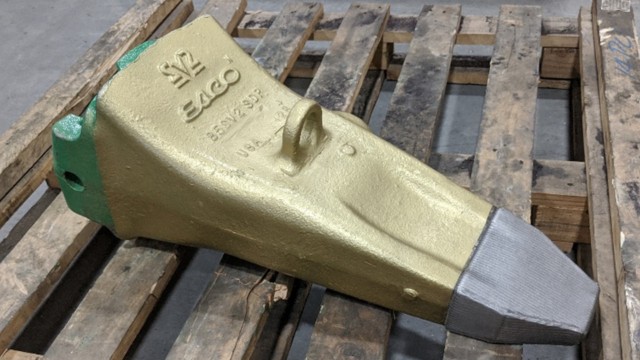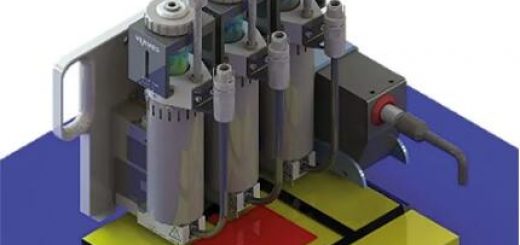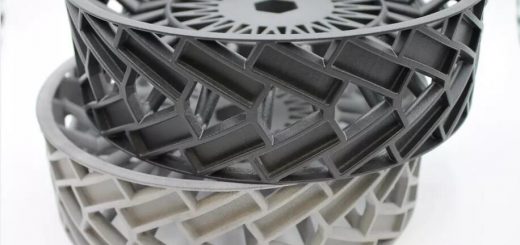More Productive Coating and Repair with Artificial Intelligence
![]() Coating wear parts more efficiently and adaptively
Coating wear parts more efficiently and adaptively
Canadian machine builders receive many orders from the mining and petroleum industries. For example, rock crusher teeth used by the mining industry need to be regularly overhauled. Using the laser material deposition (LMD) process, industries can apply new layers to the worn part until the original geometrical shape has been reconstructed.
 © Apollo Machine and Welding Ltd, Canada.
© Apollo Machine and Welding Ltd, Canada.
For complex geometries, such as on this blade tooth, or where wear is uneven, AI-based process optimization will enable significant gains in efficiency.
The catch in this repair process is the part’s uneven wear, which means that layers of varying thickness have to be applied. An operator must measure this after each coating step or at least after every tenth layer and readjust the process.
A German-Canadian consortium has set itself the task of automating control processes like these. In the project “Artificial Intelligence Enhancement of Process Sensing for Adaptive Laser Additive Manufacturing AI-SLAM”, the partners are jointly developing software for plant manufacturers that can be used to run LMD processes automatically. For this purpose, the system automatically records geometries during the coating process, detects deviations from the specified contour and readjusts process parameters, such as the feed rate.
 © Apollo Machine and Welding Ltd, Canada.
© Apollo Machine and Welding Ltd, Canada.
Wear parts like this stone crusher tooth with an outer diameter of about 140 mm are restored with the LMD process. Thanks to AI, the processes for repairing irregular surfaces shall be optimized.
The optimized control parameters are calculated with the help of Artificial Intelligence. The software analyzes a larger dataset and independently learns how to iteratively improve the process. The most recent milestone in the three-year project was commissioning the software functionality for both scanning components and automatic path planning at the Fraunhofer ILT facility.
![]() German-Canadian collaboration for more AI applications
German-Canadian collaboration for more AI applications
On the German side, the Fraunhofer Institute for Laser Technology ILT in Aachen and the software developer BCT from Dortmund are involved in AI SLAM. In Canada, the project is coordinated by the National Research Council of Canada NRC. A team from McGill University (Montreal) is responsible for the research side of the project, while Braintoy (Calgary) is involved in programming the machine learning algorithms. Apollo Machine and Welding Ltd in Alberta are participating in the project as an industrial service provider for LMD.
The focal points of the project are quite complex: Basically, as much process data as possible must be systematically collected and processed. From this data, complex routines then learn automatically how process control can be optimized in order to ultimately produce more with less effort.
The Canadian partners are continuing to develop the LMD technology for repair companies such as Apollo, which uses several tons of material annually for the repair of wear parts – such as the rock crusher tooth. Accordingly, the expectations for efficiency gains through automated process control are high.
Project work across both continents is functioning smoothly thanks to regular video meetings and jointly prepared online documents. In virtual lab tours, partners have become acquainted with each other’s software and hardware environments. To exchange process data and implement the machine learning models, Braintoy’s own web platform called mlOS (Machine Learning Operating System) has been made available to all project partners.
The AI-SLAM project will run until March 2024 as part of the 3+2 funding program with Canada. The program is funded on the German side by the Federal Ministry of Education and Research and on the Canadian side by the NRC. The focus is on using Artificial Intelligence to develop new technologies for industrial production. The individual projects come from a large variety of industries. Potential applications span a wide range; from the mining and energy sectors, to the automotive industry and telecommunications all the way to construction and infrastructure management.
Source: Fraunhofer
For press release, welcome to send to 3D Science Valley at 2509957133@qq.com




Recent Comments